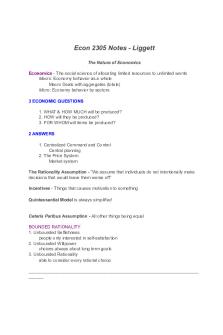Econ notes PDF

| Title | Econ notes |
|---|---|
| Course | Intro to Microeconomics |
| Institution | Tulane University |
| Pages | 6 |
| File Size | 422.5 KB |
| File Type | |
| Total Downloads | 54 |
| Total Views | 140 |
Summary
course notes...
Description
Determinants of demand - Price of the good or service - Absolute price: on the price tag, regardless of currency - Relative price: price of a good in terms of other prices (a cup of coffee is 4 bagels) - The opportunity cost of a good, what you must give up in order to purchase what you are buying - Tastes and preferences - Income and wealth - Inferior goods fluctuate price based on collective income… when income increases, demand increases - Normal goods - Quasi-linear goods - Prices of related/substitute goods - Expectations of future prices Law of Demand: when the price of a good or services increases, the quantity demanded decreases and when the price decreases the quantity demanded increases Marginal benefit: the extra benefit one receives, measured in dollars, of consuming an additional unit of a good or service→ buying in bulk Supply: the quantities of a good or service producers are willing and able to supply at various prices over a given period of time holding everything else constant Determinants of Supply: - Price of good or service - Cost of production - Prices of related goods - Complemented - Substitutes: can produce a or b (same resources used for both) - Expected future prices - technology/equipment Law of Supply: when the price of a good or service increases the quantity supplied increases and when the price decreases the quantity supplied decreases Consumer Surplus: the difference between what a customer is willing to pay and must pay for each unit
Producer Surplus: the difference between what a producer is willing to sell and what they must sell a unit
Total economic surplus: loss in economic surplus indicates unhealthy economy
Price elasticity of demand: %change of Q demanded/ %change in price
related to slope but uses it differently Perfect elasticity- horizontal demand curve, price never changes p much regardless of price b/c things are perfect substitutes (oil, strawberries in a farmers market, etc.) Perfect inelasticity- vertical demand curve, price changes completely reflective of price b/c there are no substitutes for a certain good (water, lifesaving medicine, gas prices)
Price elasticity of demand: - How many available substitutes there are - How necessary or not a good is - How much a person’s budget must be taken into account - How much time is in consideration You can only calculate price elasticity of demand between two points on the same demand curve (bc if there r 2 curves something has changed other than price - Normal good: demand goes up when income is higher - Inferior goods: all necessary goods, demand decreases when income is higher - Luxury goods: all normal goods, % demand increases proportionally with income increase - Spend more money on clothes when u have more money→ special category - Necessary goods: % demand decreases proportionally with income decrease
-
No disposables when ur poor
Slope of supply curve determines elasticity→ availability of factors of production impact price elasticity of supply
Price ceiling: government imposed ceiling on price $ below equilibrium price, tend to cause shortages
Price floor: government or market imposed floor on price $ above equilibrium, tend to cause surpluses
Deadweight loss...
Similar Free PDFs

Econ Notes
- 40 Pages

Econ notes
- 9 Pages

Econ notes
- 6 Pages

Econ CH 3 Notes - Econ Lecture
- 16 Pages

ECON 104 Lecture Notes
- 21 Pages

ECON 2 Macro Notes
- 50 Pages

Econ 2305 Notes - Liggett
- 45 Pages

ECON 1001 Lecture Notes
- 156 Pages

ECON Chapter 1 Notes
- 5 Pages

Econ Chapter 14 Notes
- 4 Pages

ECON 1010 Notes
- 36 Pages

Econ 203 Notes
- 19 Pages

ECON 122A Notes
- 103 Pages

Econ Test 1 notes
- 12 Pages

Econ 2000 Notes 2018
- 339 Pages

ECON 1001 Textbook Notes
- 43 Pages
Popular Institutions
- Tinajero National High School - Annex
- Politeknik Caltex Riau
- Yokohama City University
- SGT University
- University of Al-Qadisiyah
- Divine Word College of Vigan
- Techniek College Rotterdam
- Universidade de Santiago
- Universiti Teknologi MARA Cawangan Johor Kampus Pasir Gudang
- Poltekkes Kemenkes Yogyakarta
- Baguio City National High School
- Colegio san marcos
- preparatoria uno
- Centro de Bachillerato Tecnológico Industrial y de Servicios No. 107
- Dalian Maritime University
- Quang Trung Secondary School
- Colegio Tecnológico en Informática
- Corporación Regional de Educación Superior
- Grupo CEDVA
- Dar Al Uloom University
- Centro de Estudios Preuniversitarios de la Universidad Nacional de Ingeniería
- 上智大学
- Aakash International School, Nuna Majara
- San Felipe Neri Catholic School
- Kang Chiao International School - New Taipei City
- Misamis Occidental National High School
- Institución Educativa Escuela Normal Juan Ladrilleros
- Kolehiyo ng Pantukan
- Batanes State College
- Instituto Continental
- Sekolah Menengah Kejuruan Kesehatan Kaltara (Tarakan)
- Colegio de La Inmaculada Concepcion - Cebu